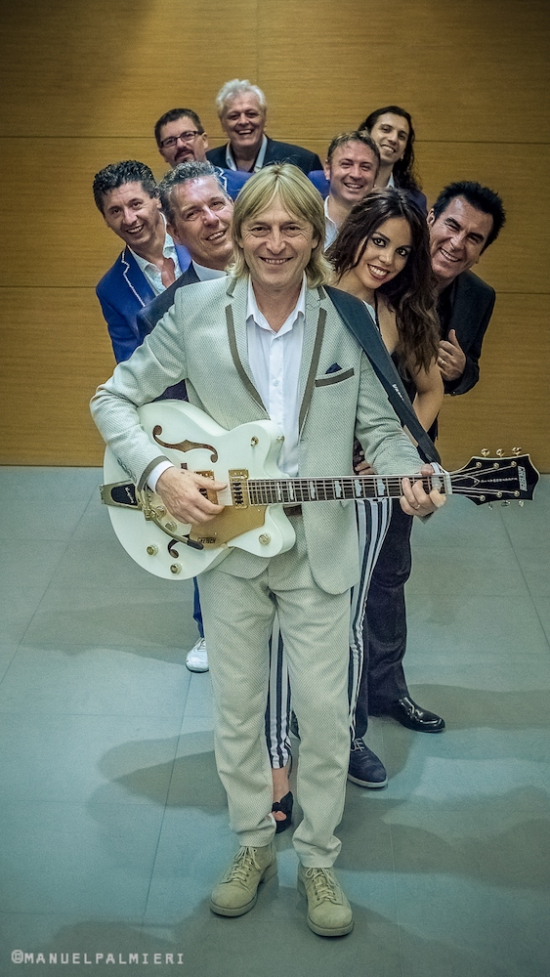Moreno Conficconi, stage name Moreno “Il Biondo” (the blonde man) is one of the most famous Italian liscio artists. Maybe somebody remembers him as one of the protagonists of the music video by Elio e le Storie Tese La Terra dei Cachi (where he featured together with the whole Raoul Casadei Orchestra), one of the many times he has ventured into other musical fields.
And we would like to talk with him precisely about these unexplored territories. But first, a little of history.
«The spark that turned on my passion for liscio ignited quite soon: I was 13 and was already studying clarinet at the Music High School in Forlì. In my village, in 1971, there was the “Tote Party Night”, where people used to bring food from home in a tote and, some time during the night, stopped dancing and started to eat. The great Secondo Casadei was playing that night. It was one of the last concerts of the king of liscio, who died in November the same year. I was struck by his orchestra: refined, serious and at the same time cheerful, with a phenomenal clarinettist that, by the way, was my uncle, Franco Bergamini. My uncle had already introduced me to the execution of liscio and folk songs. But the unwritten rules of the classical music world “forbade” me to play anything but the academic repertoire, and I was quite gifted at classical music and was already holding concerts in other schools. Every time I “secretly” held liscio concerts or participated in any other kind of shows, as soon as I got back to class, my clarinet teacher immediately realized what I had done. He used to say that I had changed the grip style and the sound was no longer the same... and I had to start all over again!
Nevertheless, that “Tote Party Night” changed my life and since then my only wish was to “become a member of the Casadei Orchestra”.
I started working my way up the ladder. From the age of 14 to 18 I played in several liscio orchestras considered as “minor” although they were led by significant artists like Daniela Rosy and Bruna Lelli. Then I had my call-up. And, when I got back from the military service, I started my own band, Moreno C. Gruppo Italia: it lasted two years, and it was a learning experience, although not completely positive.
From 1982 things started to go well and I put together the orchestra named Franco Bergamini Classica Internazionale with my uncle. Then, during the Nineties I joined Raoul Casadei’s orchestra.
From 1990 to 2000 I was his right-hand man: I was the president of the cooperative, the arranger, the frontman and the owner of the agency. I had the opportunity to experience all the operational aspects of the world of liscio dance.
In 2000 I left Raoul to venture in the new millennium all by myself: it was not easy, it took me a lot of courage. My choice allowed me to come into contact with different musical contexts, also thanks to my participation in the National Singers Soccer Team, where the greatest Italian singers considered me a peer: this was a huge gratification, an important recognition for my musical career.
In 2002 I started the Orchestra Grande Evento, at the time when the saxophone virtuoso Fiorenzo Tassinari stopped playing with Raoul Casadei as well. We decided to get back together in a band that could recall the golden years of liscio, including also the singer Mauro Ferrara, who had left Casadei’s orchestra in 2000, like me.
We actually called it “big event” because it brought back together a series of extraordinary musicians, any of them could have been the leader of his own orchestra. The main protagonists were, and still are, Fiorenzo Tassinari, Mauro Ferrara, the accordionist Walter Giannarelli, the trumpet player Enrico Milli, the singer Annamaria Allegretti (who will leave the orchestra in 2018 to start her own group), Roberto Forti on drums, the guitar virtuoso Walter D’Angelo and the bass player Giuseppe Zaghini, who recently joined the band.
Another novelty came in 2015 with Mirco Mariani’s Extraliscio, a project which rejuvenated me, bringing me back to when I was 13.
The liscio has changed a lot over the years, moving away from its origins. This music genre was born to be played live, demanding the sweat of the performance: although, during the last 25 years, it has been favouring visual impact, mere stage effects, screens, led lights, moving heads. More and more frequently, live music has been replaced by playback, therefore guaranteeing an absolute sound perfection but becoming colder and completely losing the most instinctive connection with the audience. Finally, when spectacular megalomania started to become monotonous and tiring, the audience and the dancers realized that the early emotion of the liscio dance had vanished.
During the last years there have been obvious signs of recovery, especially thanks to the comeback of folklore, with its numerous possible reinterpretations, and to the revival of an increasingly engaging live performance.
Liscio is an “ugly word”, which has unfortunately pushed everything and everybody away, because it has been devastated over the years. It has never been pronounced in an objective way, transfigured by egocentrism, excesses, and heavily influenced by market logics.
Over the years I too have felt the need to conform to the tastes of the audience and of the market but at the same time I tried not to divert my path and not to forget the story of my music and its evolution.
I have always attempted to juxtapose the liscio with musical experiments and cross-fertilisations, since when I was a member of Raoul Casadei’s orchestra. In 1996, for example, I invested on the “Latin of Romagna”, or rather folk arrangements and Latin American sounds. After leaving Raoul’s band I carried out another experiment: playing liscio with a real latin band, the Orchestra Mediterranea, but the experiment didn’t work out well, it was unbalanced.
A significant push toward cross-fertilisations arrived when, in 2013, the Ravenna Festival decided to juxtapose Secondo Casadei’s music and symphonic arrangements. I was in charge of the performance, entitled “Secondo a nessuno”, during which my entire orchestra played Secondo’s greatest classics along with the large orchestra’s arrangements executed by the symphonic orchestra Cherubini directed by Riccardo Muti.
This event was followed by a small tour in the theatres, where the orchestral arrangements were reduced to a chamber orchestra, a string quintet. These were actual attempts to export the traditional liscio from Romagna within the academic and erudite circle.
Then there was the pure theatrical experience with Vitelloni in balera, a musical comic show that mixed liscio music and tales, put together with the Sestetto 1928 band, which recalled the traditional ensemble of the primordial liscio.
It can be said that the arrival of Extraliscio was the completion of this journey. The experiments with this music genre previously consisted in “mimicking” the classics of the genre or replacing the traditional instruments with completely different instruments (for example, playing the saxophone parts with the Hammond organ…). But nothing more.
Extraliscio has triggered the enthusiasm, has paved the way for an actual contamination and transfiguration of the folklore from Romagna; at the same time, this same path has been taken by the excellent Mr. Zombie Orchestra and by the Minor Swing Quintet of the violinist Alessandro Cosentino.
Since I’ve been encouraged to choose a song, I feel like recommending one I have written myself, taking the risk of resulting megalomaniac. It is entitled La Romagna nel cuore and is a small tableau of Romagna, a song which has not been very successful.
There are so many songs from Romagna with an extraordinary value, therefore I prefer to recommend a little song of mine, honest and unpretentious.»
Extraliscio has triggered the enthusiasm, has paved the way for an actual contamination and transfiguration of the folklore from Romagna; at the same time, this same route has been taken by the excellent Mr. Zombie Orchestra and by the Minor Swing Quintet of the violinist Alessandro Cosentino.
Since I’ve been encouraged to choose a song, I feel like recommending one I have written myself, at the risk of seeming megalomaniac. It is entitled La Romagna nel cuore and is a small tableau of Romagna, a song which has not been very successful.
There are so many songs from Romagna with an extraordinary value, that I prefer to recommend a little song of mine, honest and unpretentious.»
ROMAGNA IN YOUR HEART (ballad)
(Music by M. Conficconi, F. Tassinari - Lyrics by M. Conficconi, M. Ferrara, S. Scrivani. Edizioni Musicali Caramba / Edizioni Musicali Bei Tempi / Edizioni Musicali Casadei Sonora)
It may be that sun at dawn
that lights up the shore
it may be the craving for adventure
that I keep inside of me.
Romagna in your heart
makes you live a dream
the breath of the sea
the village feast
the love affairs.
Romagna in your heart
the stories its poems
traditions of people
living their lives
and thinking of you.
It may be like the sunset
that turns off the hill
it may be evening lights
the nights I spend with you.
Romagna in your heart
makes you live a dream
the breath of the sea
the village feast
the love affairs.
Romagna in your heart
the stories its poems
traditions of people
living their lives
and thinking of you.
Romagna in your heart
the stories its poems
traditions of people
living their lives
and thinking of you.

